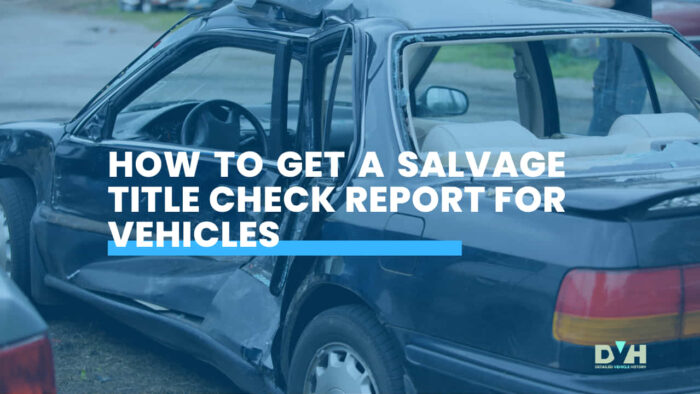If you are buying a used car in California, it’s best to follow the proper procedure to avoid purchasing a vehicle with defects and damages. This procedure involves carrying out a mechanical inspection, going for a test drive, and, most importantly, checking the history of the vehicle you are interested in. With a salvage title check, you can be sure to differentiate between a reliable vehicle and one that just isn’t good enough or roadworthy. In this article, we will be taking a look at the steps to follow to get a salvage title check and generate a report to avoid purchasing a damaged vehicle.

What is a salvage title?
If you are out there searching for a used vehicle, there’s a huge possibility that you’ve heard about salvage titles. These titles are given to vehicles that have been damaged to the point where they are now considered a total loss by an insurance company. These damages could have been caused by collisions, floods, fire, or any other type of incident that led to significant damage to the car or truck. When a vehicle is considered a total loss by insurance companies, it means that carrying out repairs on it would cost almost as much as the vehicle’s fair market value, and as such, it’s not worth it. Instead, the fair market value of the vehicle is paid in full to the owner by the insurance company, and the car is given a salvage title.
Salvage-title vehicles are often sold at a lower price than their clean-titled counterparts, making them an attractive option for budget-conscious buyers. However, purchasing a salvaged vehicle can come with its own set of risks. Since these vehicles have been severely damaged, they can have hidden problems that may not be immediately apparent. That’s why it’s essential to get a salvage title check report before making a purchase.
What is a salvage title check report?
A salvage title check report is a comprehensive vehicle history report that provides information about a vehicle’s title status and any accidents, repairs, or damage that it may have sustained throughout its life. The report provides a detailed overview of a vehicle’s history and can help you make an informed decision about whether or not to purchase a salvage title vehicle. With a salvage title VIN check, you can verify a vehicle’s salvage status and be completely sure that you are not being scammed. Usually, salvage-title cars are repaired before being put up for sale at dealerships and given rebuilt titles.
Does a rebuilt title affect a vehicle’s value? We have a comprehensive answer to this question in this article: How much does a rebuilt title affect a vehicle’s value?
With a salvage title check, you can confirm if there have been any fixes or if the vehicle is not roadworthy. In this report, you can also verify the potential defects the vehicle may have in the future. Interesting, right? At least you can be sure of the decision you’re making before completing the purchase at a dealership, private sale, or online marketplace.
Now, let’s look at some of the benefits of getting a salvage title check and generating a report.
Benefits of Getting a Salvage Title Check Report
Several vehicle history report providers are offering this service, and with the right provider, you can be sure of having a lot of information. Detailed Vehicle History offers this service to car buyers and owners and generates detailed reports for them instantly. With the report, you can be certain that your vehicle is roadworthy and safe to drive. You can also identify hidden problems and more. In detail, some of the benefits of checking if your vehicle is salvage title-free are:
Identifying hidden problems
A salvage title check report can help identify hidden problems that may not be immediately apparent to the buyer. This can include structural damage, airbag deployment, or other safety hazards that could affect the vehicle’s performance or safety. How can you spot these problems? Take a good look at the accident history and damage history. You can also check the open recalls section to determine if your vehicle has any recalls that need attention.
These reports play a big role in preventing unnecessary expenses after purchases. Who wants to spend money on repairs? No one, I suppose.
Ensuring the vehicle is legitimate
A salvage title check report can help ensure that the vehicle is legitimate and has not been reported stolen or involved in any criminal activity. Detailed Vehicle History provides a “Theft History” section that car buyers and owners can view to determine if the vehicle was stolen or not. This is an easy way to avoid car scams. Apart from this section, the ownership section can help you determine if the seller is the vehicle owner or if the car was stolen, especially when purchasing from a private seller.
Negotiating a Better Price
Are you negotiating based on the dealer’s asking price? Have you checked the salvage title with the VIN? Salvaged vehicles are usually sold cheaper than clean-titled cars because of the significant problems and safety hazards that the vehicle may have. According to Edmunds, cars with salvage titles lose 20 to 40% of their value. This only means that you should be able to get a salvage car at a cheap price. If you aren’t, then it’s best to walk away from the deal. Make sure to review the report properly and not miss any important information.
READ ALSO: Differences Between A Salvage Title and Rebuilt Title
Are there downsides to purchasing a salvage title?
Salvage vehicles are generally not recommended, as they come with a lot of potential defects even after repairs, and you may face some difficulties. Try to remember these before paying for that vehicle:
Difficulty Insuring the Vehicle
Insurance companies may be hesitant to provide coverage for a salvage title vehicle, which can make it challenging to obtain insurance. These companies see salvage cars as total losses, so they just don’t want to have anything to do with them. This means that you must be careful before you make your decision. It’s best to conduct research and find an insurance provider willing to insure a salvage car before you pay for it.
Difficulty Reselling the Vehicle
Since salvage title vehicles have been severely damaged, they may be more challenging to resell compared to clean-titled vehicles. These vehicles usually lose their value after they are declared total losses, and if purchased, they may yield nothing less than a few dollars. It’s best to consider this before completing the payment.
Difficulty Finding Replacement Parts?
Salvage title vehicles may require unique replacement parts that are challenging to find, which can make repairs more expensive.
Now, let’s get down to business.
How to check salvage title by VIN
Getting a salvage title check report from Detailed Vehicle History is a relatively simple process. Here are the steps you need to follow:
Step 1: Obtain the Vehicle Identification Number (VIN)
Do you have the VIN number of the vehicle you are interested in? The VIN is made up of 17 characters (or less in classic vehicles) and can be used to gain access to every record on a vehicle. To find it, all you need to do is check for this code (made of letters and numbers) on the dashboard, the driver’s side door, the certificate of title, insurance documents, and other vehicle registration documents. After getting these documents, proceed to the next step.
Step 2: Visit the Detailed Vehicle History Website
There are several online salvage title check providers available, but Detailed Vehicle History provides detailed information. So with the VIN, visit our website and navigate to the VIN check tool. With the VIN check tool, you will also gain access to hidden records and other details, such as:
- Accident history
- Damage history
- Theft records
- Title brand records
- Open recalls
- Lien and loan records
- Service records
- Maintenance schedule
- Ownership history, and more.
Step 3: Fill out the provided form and enter the VIN
Once you have located the VIN check tool, all you need to do is provide your VIN and contact information. Select “VIN Check,” and you will immediately be provided with information about the vehicle.
After running a VIN check, you will be provided with a detailed report containing the full records of your vehicle. With these records, you can easily determine if the vehicle has a clean title or has title marks. Review the titles on your vehicle properly and determine if it’ll be a good investment for you or not. Additionally, instead of using a VIN check, you can obtain window stickers by VIN for your vehicles.










